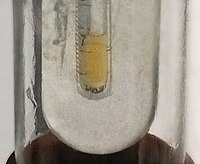
Photo from wikipedia
Using persulfate (PS) oxidation to remove the persistent perfluorooctanoic acid (PFOA) in water typically requires an elevated temperature or an extended reaction time. Under relatively ambient temperatures (15-45 °C), feasibility of… Click to show full abstract
Using persulfate (PS) oxidation to remove the persistent perfluorooctanoic acid (PFOA) in water typically requires an elevated temperature or an extended reaction time. Under relatively ambient temperatures (15-45 °C), feasibility of employing PS with iron-modified activated carbon (AC) for PFOA oxidation was evaluated. With presence of Fe/AC in PS oxidation, 61.7% of PFOA was decomposed to fluoride ions and intermediates of short-chain perfluorinated carboxylic acids (PFCAs) with a 41.9% defluorination efficiency at 25 °C after 10 h. Adsorption of PFOA onto Fe/AC can be regarded as a pre-concentration step prior to subsequent oxidation of PFOA. Fe/AC not only removes PFOA through adsorption, but also activates PS to form sulfate radicals that accelerate the decomposition and mineralization of PFOA. With Fe/AC in the PS system, activation energies (Ea) of PFOA removal and defluorination were significantly reduced from 66.8 to 13.2 and 97.3 to 14.5 kJ/mol, respectively. It implies that PFOA degradation and defluorination could proceed at a lower reaction temperature within a shorter reaction time. Besides, the surface characteristics of AC and Fe/AC before and after PS oxidation were evaluated by XPS and SEM. A quenching test used MeOH as an inhibitor and EPR spectra of free radicals were conducted to develop the proposed reaction mechanisms for PFOA oxidation.
Journal Title: Water research
Year Published: 2020
Link to full text (if available)
Share on Social Media: Sign Up to like & get
recommendations!